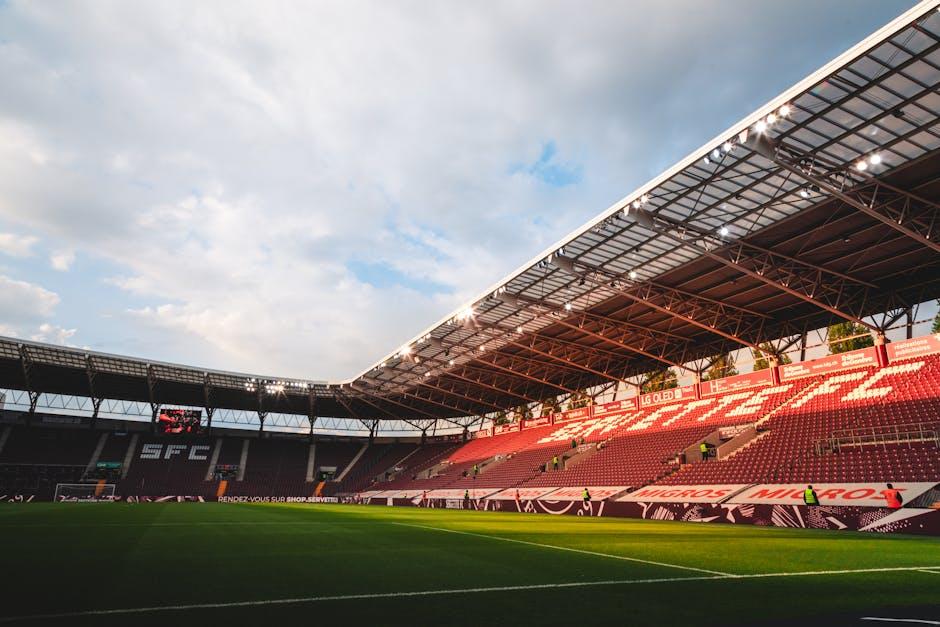Baseball, often hailed as America’s pastime, has long been a sport of tradition and timeless appeal. Yet, beneath the crack of the bat and the roar of the crowd, the game is evolving at a rapid pace. From cutting-edge technology to shifting player dynamics and changing fan engagement, the future of baseball promises to be as dynamic as the game itself. In this article, we dive into the emerging trends that are shaping the next era of baseball, offering a glimpse at what fans, players, and the industry can expect in the years to come.
Table of Contents
- Emerging Technologies Shaping the Game Experience
- Evolving Player Performance Analytics and Training Methods
- The Impact of Sustainability on Stadium Design
- Shifts in Fan Engagement and Digital Interaction
- The Role of Diversity and Inclusion in Baseball’s Growth
- Predictions for Global Expansion and Market Trends
- Q&A
- The Way Forward

Emerging Technologies Shaping the Game Experience
As technology continues to evolve, the baseball experience is being revolutionized by innovations that blend digital precision with real-world athleticism. From advanced analytics using AI to enhance player performance to immersive fan engagement through augmented reality, the sport is witnessing an exciting transformation. Teams now leverage wearable devices that track player health and fatigue in real-time, reducing injuries and extending careers. Meanwhile, VR training simulations allow athletes to face virtual pitchers or hitters, refining their skills before stepping onto the field.
The fan experience is equally dynamic, fueled by interactive platforms and data visualization tools that bring every pitch, swing, and catch to life. Stadiums are integrating smart seating and 5G connectivity, making it possible to access instant replays, player stats, and personalized content on-demand. Below is a snapshot of some cutting-edge technologies reshaping baseball:
- AI-powered scouting and analytics for strategic decision-making
- Wearable sensors monitoring player biometrics
- Augmented reality overlays enhancing live broadcasts
- Virtual reality for immersive training experiences
- Smart stadiums offering seamless fan interaction
| Technology | Impact | Application |
|---|---|---|
| AI Analytics | Improves strategy and player evaluation | Game tactics, scouting reports |
| Wearable Tech | Monitors athlete health | Injury prevention, performance tracking |
| Augmented Reality | Enhances fan engagement | In-game stats, interactive broadcasts |
| Virtual Reality | Simulates gameplay scenarios | Training and skill development |
| Smart Stadiums | Improves fan connectivity | Mobile apps, real-time content |

Evolving Player Performance Analytics and Training Methods
As technology continues to redefine the boundaries of athletic potential, baseball has embraced a new era of performance analytics and training techniques. Gone are the days when coaches relied solely on instinct; today’s data-driven models dissect every pitch, swing, and sprint with surgical precision. Wearable sensors and high-speed cameras now capture granular metrics like spin rate, launch angle, and reaction times, transforming raw data into actionable insights that tailor training regimens uniquely to each player’s physiological and psychological profile.
Modern training facilities blend traditional drills with cutting-edge simulations, enabling players to visualize in-game scenarios through augmented reality and virtual reality experiences. This fusion of innovation not only sharpens mental acuity but also accelerates skill acquisition and injury prevention. Key advancements shaping this transformation include:
- Biomechanical Analysis: Real-time feedback on body mechanics for optimized movements.
- AI-driven Video Breakdown: Automated identification of weaknesses and tendencies.
- Personalized Conditioning Programs: Tailored workouts based on biometric trends.
| Technology | Primary Benefit | Impact on Training |
|---|---|---|
| Motion Capture Suits | Precision Movement Tracking | Enhanced form and injury reduction |
| Virtual Reality Simulators | Game Scenario Rehearsal | Improved decision-making under pressure |
| Wearable Biometrics | Health Monitoring | Optimized recovery and stamina management |

The Impact of Sustainability on Stadium Design
Modern stadiums are no longer just about seating capacity and fan experience; they are becoming beacons of environmental responsibility and innovation. Sustainable design principles are fundamentally reshaping how new ballparks are constructed and how existing venues are retrofitted. Materials sourced locally and recycled components play a significant role in reducing carbon footprints, while green roofing systems help manage energy consumption and enhance air quality. These eco-friendly stadiums are designed to optimize natural light and airflow, reducing the need for artificial heating and cooling, thus slashing operational costs and environmental impact simultaneously.
Fans and franchises alike benefit from smarter infrastructure that supports sustainability. Consider the integration of:
- Solar panels to power LED lighting and electronic scoreboards,
- Rainwater harvesting systems for field irrigation and facility cleaning,
- Electric vehicle charging stations to promote greener transportation options.
Below is a quick overview of how sustainable stadium features compare in terms of energy efficiency and fan engagement:
| Feature | Energy Savings | Fan Appeal | Implementation Cost |
|---|---|---|---|
| Solar Panels | High | Moderate | Medium |
| Green Roofing | Medium | High | High |
| Rainwater Systems | Low | Moderate | Low |
| EV Charging Stations | Minimal | High | Medium |

Shifts in Fan Engagement and Digital Interaction
As baseball evolves, so does the way fans connect with their favorite teams and players. The days of passive spectating are giving way to dynamic digital experiences that bring the crowd closer than ever before. From interactive apps offering real-time stats and player insights to augmented reality features that transform the stadium experience, technology is enhancing engagement on multiple fronts. Fans are no longer just observers; they are active participants shaping the story of each game through social media and live polls during broadcasts.
Several shifts are redefining the fanbase landscape:
- Personalized Content: Tailored highlights and updates delivered based on individual preferences.
- Second-Screen Experiences: Complementary content on smartphones and tablets during games.
- Virtual Communities: Online forums and platforms where fans share opinions and predictions in real-time.
| Engagement Tool | Fan Impact | Example |
|---|---|---|
| Interactive Stats Dashboards | Deepens understanding of game mechanics | MLB At Bat app |
| AR Stadium Experiences | Immerses fans with virtual replays and player info | Stadium AR zones |
| Live Social Voting | Enables fan-driven game moments | Social media polls |

The Role of Diversity and Inclusion in Baseball’s Growth
Baseball’s evolution is deeply intertwined with the strides made in embracing diversity and fostering inclusion. These principles have become essential not just for enhancing the sport’s appeal, but for enriching the game culturally and competitively. By welcoming players from various ethnic backgrounds, genders, and abilities, baseball is opening its diamond to fresh perspectives that fuel innovation and community engagement. This inclusivity transcends the field, influencing coaching strategies, fan interactions, and even the marketing of the sport, creating an environment where every voice shapes the future of baseball.
Key areas spotlighting diversity and inclusion in baseball’s growth include:
- Global Talent Integration: Expanding recruitment to untapped regions and demographics.
- Community Outreach: Programs aimed at underrepresented youth fostering early interest and access.
- Inclusive Leadership: Diversifying front-office and managerial roles to reflect a broad range of experiences.
- Adaptive Gameplay: Introducing rules and equipment modifications to accommodate all athletes.
| Aspect | Impact | Example |
|---|---|---|
| Women in Baseball | Broadening fan base and talent pool | Establishment of female baseball leagues and mixed-gender tournaments |
| International Players | Elevated competition level and fan diversity | Notable MLB stars from Asia, Latin America, and Africa |
| Accessibility Innovations | Enhanced participation for athletes with disabilities | Adaptive equipment and specialized training programs |

Predictions for Global Expansion and Market Trends
Baseball’s footprint is stretching far beyond its traditional bastions in the Americas and East Asia. Emerging markets in Europe, Africa, and Southeast Asia are witnessing a surge in grassroots initiatives, fueled by increasing access to streaming platforms and social media exposure. Key regions such as Germany and Brazil are investing in youth academies and professional leagues, anticipating a new generation of talent and fans eager to embrace the sport. This global momentum is also attracting international sponsors, creating a vibrant ecosystem where local cultures blend with baseball’s timeless appeal.
Market trends indicate a strategic focus on fan engagement and technology integration to captivate younger audiences worldwide. Innovations such as augmented reality experiences at stadiums, AI-powered analytics for player development, and blockchain-based memorabilia trading are reshaping how fans connect with the game. Alongside increasing diversity in player rosters and leadership roles, these advancements promise a dynamic, inclusive future. The table below highlights projected growth metrics for emerging baseball markets through 2030:
| Region | Fanbase Growth (%) | New Professional Teams | Sponsorship Revenue ($M) |
|---|---|---|---|
| Europe | 35 | 12 | 45 |
| Africa | 42 | 5 | 20 |
| Southeast Asia | 38 | 9 | 33 |
- Digital Innovations: Virtual tickets and immersive broadcasts expand fan reach.
- Global Talent Pools: Scouting networks tap into diverse skill sets across continents.
- Community-Centric Teams: Localized branding fosters strong neighborhood support.
Q&A
Q&A: The Future of Baseball – Trends to Watch
Q1: How is technology changing the way baseball is played and experienced?
A1: Technology is transforming baseball both on and off the field. Advanced analytics and wearable tech help players fine-tune their skills and strategies. Fans benefit from augmented reality broadcasts, real-time data visualization, and interactive apps that deepen engagement. From high-speed cameras capturing every pitch to AI-driven scouting reports, the sport is becoming more data-rich and immersive.
Q2: Will changes to game rules shape the future of baseball?
A2: Absolutely. MLB and other leagues are experimenting with rule tweaks aimed at speeding up games and increasing action—such as pitch clocks, limits on mound visits, and larger bases to encourage steals. These adjustments seek to maintain baseball’s classic charm while making it more appealing to younger and more diverse audiences.
Q3: What role does player health and longevity play in baseball’s future?
A3: Player health is paramount. With advances in sports medicine and injury prevention, athletes can enjoy longer, more productive careers. Emphasis on recovery protocols, nutrition, and biomechanics is helping reduce common injuries, allowing fans to see their favorite stars perform at peak levels for more seasons.
Q4: How is baseball addressing diversity and inclusion for its future growth?
A4: Baseball’s future depends on embracing and promoting diversity at all levels—from grassroots programs to the major leagues. Initiatives aim to broaden access, encourage participation from underrepresented communities, and celebrate the sport’s global appeal. Inclusivity initiatives foster a richer, more dynamic baseball culture.
Q5: Will baseball evolve internationally in the coming years?
A5: The international growth of baseball is undeniable. Professional leagues in Asia, Latin America, and Europe are gaining traction and talent pipelines are increasingly global. The sport’s future may hinge on more international competitions, cross-border collaborations, and the expansion of global fan bases.
Q6: What could be the impact of sustainability efforts on baseball’s future?
A6: Environmental sustainability is becoming a key focus. Stadiums are incorporating eco-friendly practices like solar energy, zero-waste initiatives, and water conservation. These efforts not only reduce baseball’s carbon footprint but also align the sport with broader social responsibility trends that matter to fans and communities alike.
This Q&A offers a snapshot of the exciting directions baseball is headed—blending tradition with innovation to keep the game vibrant for generations to come.
The Way Forward
As the crack of the bat echoes into the coming decades, baseball stands at a crossroads where tradition meets innovation. With technology reshaping how the game is played, analyzed, and enjoyed, and new generations bringing fresh passion to the diamond, the future of baseball promises to be as dynamic as the sport itself. Whether you’re a purist or a futurist, keeping an eye on these emerging trends will ensure you stay connected to the ever-evolving heart of the game. After all, baseball’s story is far from over—it’s just stepping up to the plate for its next great inning.


